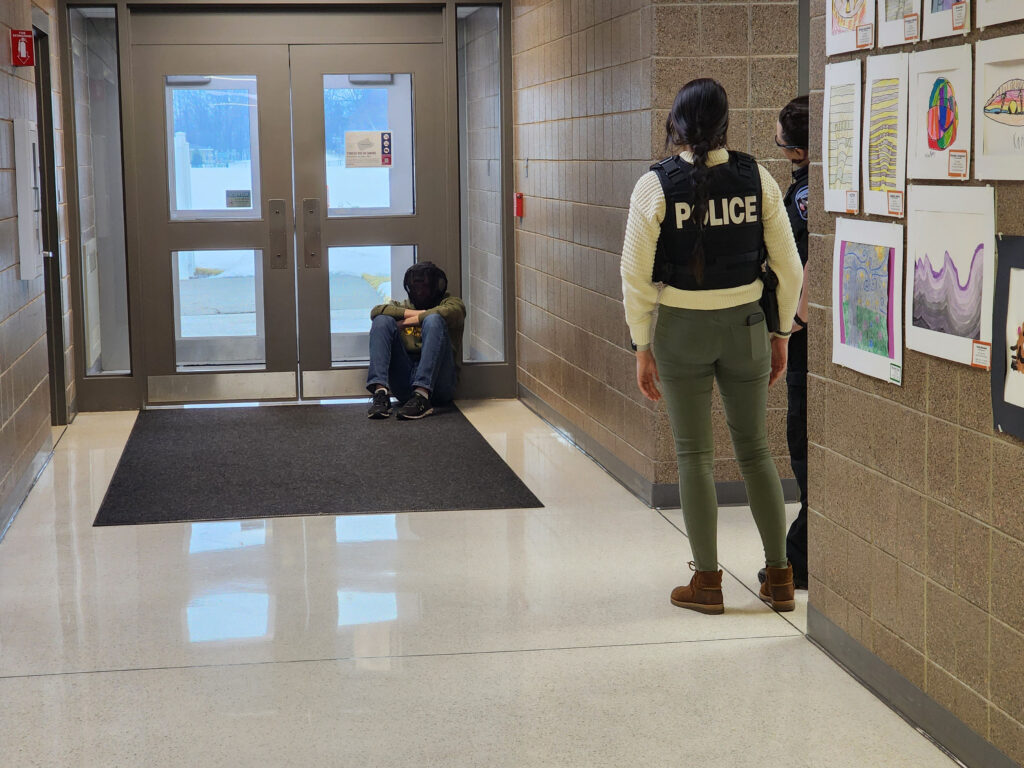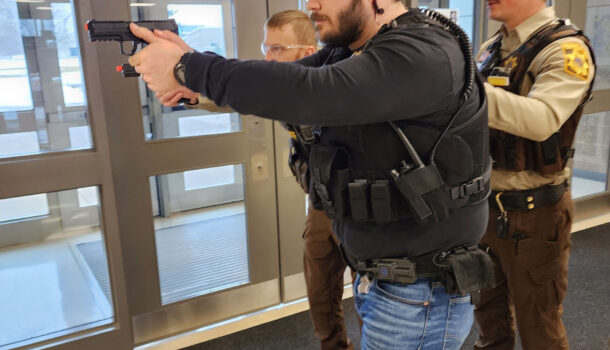“We’re trying to make it a little more realistic. They may be using force. They may be using communication skills. They’re not exactly sure what is coming.”
Dalton Dey sat in a corner of the Chippewa Valley Technical College building in Menomonie, sobbing.
He held a realistic-looking knife in his hands.
Menomonie Police Officers Kayla Tisol, an investigator, and her partner, Kelly Pollock, a lieutenant, approached the young man.
“Hi, my name is Kayla,” Tisol said. “I work with the police department. We received a call because you’re crying in the hallway. Can you put the knife down?”
This is only a drill, but Tyler Ingebretson, a Menomonie police officer who participated in the law enforcement training in the CVTC building, said calls like this are typical.
“We see these types of calls for welfare checks every shift or every other shift,” he said. “It’s a common call.”

Chad Mroczenski, a lieutenant with the Menomonie Police Department, said he’s been leading trainings like this for Dunn County law enforcement agencies for nearly 20 years.
“We like to train in buildings within our community to get familiar with them,” he said while scenarios were playing out down the hallway of the College last week. “It’s difficult to find space to be able to train … so we have to utilize buildings that are already occupied – like in schools during spring break. This works perfectly for us.”
It works for CVTC too.

Dan Lytle, CVTC Menomonie campus manager, said the training benefits the College because local law enforcement members become familiar with the building as they run through exercises.
“This provides law enforcement groups with access to our building and, as a result, they become familiar with our space,” Lytle said. “If the need arises to sweep the building following an emergency, they have a very detailed understanding of our space.”
Menomonie Police Department, Dunn County Sheriff’s Office, UW-Stout Police, Colfax Police Department and the Wisconsin State Patrol worked on different tactics like clearing rooms, communication with each other and their subjects, and other protocols and procedures. Mroczenski said one of the most important concepts during training is to give law enforcement members well-rounded scenarios.
“We want to avoid getting in the mindset of training one way,” he said. “If you go to a firearms training, you know you’re going to shoot a gun. If you go to a defensive tactics training, you know you’re going to be wrestling with somebody.
“We’re trying to make it a little more realistic. They may be using force. They may be using communication skills. They’re not exactly sure what is coming.”
Pollock, the police lieutenant, said in the first scenario they saw the weapon, and after a brief conversation with Dey, they realized he wasn’t waving it at them and didn’t intend to hurt anyone. But the weapon isn’t always visible and people they encounter don’t always want to talk.
“We don’t always know what they have or don’t have, but it’s taking the time to talk about it and get them to feel comfortable,” Pollock said.
Officer Tisol said when she encounters someone going through a tough time, her soft demeanor and compassion seems to de-escalate a situation.
“I just say, ‘Hi, I’m Kayla,’ not Officer so-and-so,” she said. “Being a little bit more sensitive to the situation is a benefit. Making people feel understood and appreciated helps.”
In the second scenario, a perpetrator runs away and another is hiding in a room with a weapon.
Groups of three officers and deputies ran the drill, practicing what they’ve been taught. They talked about slowing down the situation, not putting themselves in harm’s way and protecting life not property.
Mroczenski debriefed with the law enforcement members after each drill and was pleased with the outcomes.
“One of the things you think about when an officer shows up in uniform is, ‘I’m going to jail.’ You think of them as an officer. You don’t think of them as a person,” Mroczenski said. “We’re people first. We’re doing a job that requires us to wear a uniform and put ourselves in these situations.
“We want to show people that we’re human, too.”


